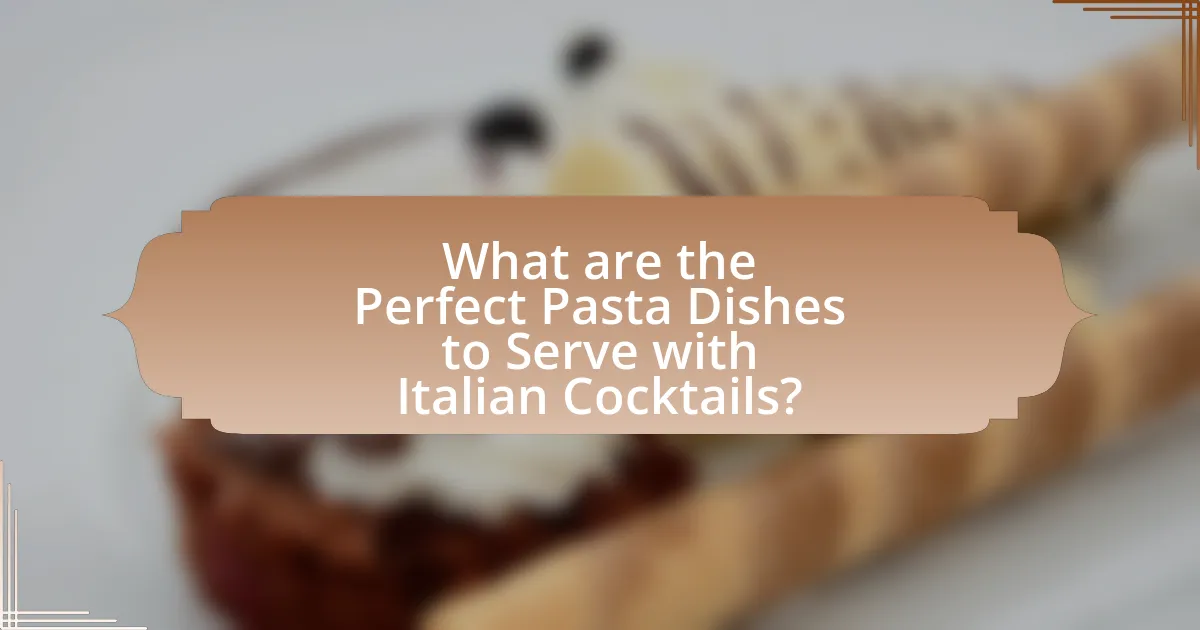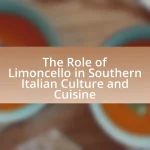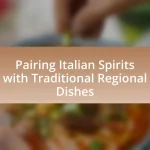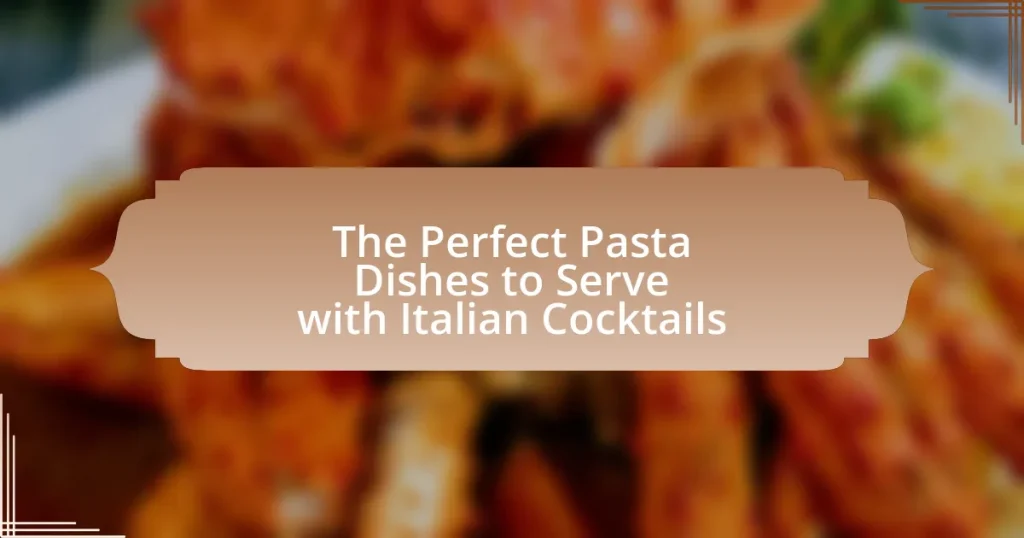The article focuses on the ideal pasta dishes to serve with Italian cocktails, highlighting specific pairings such as Spaghetti Aglio e Olio with Negroni, Fettuccine Alfredo with Aperol Spritz, and Penne Arrabbiata with Bellini. It discusses how flavors and textures in pasta enhance the cocktail experience, emphasizing the importance of sauce selection and regional variations in pasta. Additionally, the article outlines popular Italian cocktails, portion sizes, and presentation tips to create a balanced and visually appealing dining experience. Overall, it provides a comprehensive guide to harmonizing pasta and cocktails based on traditional Italian culinary practices.

What are the Perfect Pasta Dishes to Serve with Italian Cocktails?
Perfect pasta dishes to serve with Italian cocktails include Spaghetti Aglio e Olio, Fettuccine Alfredo, and Penne Arrabbiata. Spaghetti Aglio e Olio, made with garlic, olive oil, and chili flakes, complements cocktails like Negroni due to its simplicity and bold flavors. Fettuccine Alfredo, rich and creamy, pairs well with lighter cocktails such as Aperol Spritz, balancing the richness with refreshing citrus notes. Penne Arrabbiata, featuring a spicy tomato sauce, enhances the experience of cocktails like Bellini, as the heat from the dish contrasts nicely with the sweetness of the drink. These pairings are based on traditional Italian culinary practices that emphasize harmony between food and drink.
How do pasta dishes complement Italian cocktails?
Pasta dishes complement Italian cocktails by enhancing the overall dining experience through their flavors and textures. The rich, savory profiles of pasta, such as those found in classic dishes like spaghetti carbonara or fettuccine alfredo, create a harmonious balance with the refreshing and often bitter notes of cocktails like Negroni or Aperol Spritz. This pairing is supported by the Italian culinary tradition, which emphasizes the importance of matching food and drink to elevate both. For instance, the acidity in cocktails can cut through the creaminess of pasta sauces, while the herbal elements in cocktails can accentuate the freshness of ingredients used in pasta dishes.
What flavors in pasta enhance the cocktail experience?
Flavors in pasta that enhance the cocktail experience include garlic, herbs, and citrus. Garlic adds a robust depth that complements the complexity of cocktails, while herbs like basil and parsley provide freshness that balances the drink’s flavors. Citrus notes, such as lemon or orange zest, create a bright contrast that can elevate the overall tasting experience. These flavor profiles are commonly found in Italian cuisine, which is known for its harmonious pairing with cocktails, particularly those featuring vermouth or aperitifs.
How does the texture of pasta influence pairing with cocktails?
The texture of pasta significantly influences cocktail pairing by affecting the overall mouthfeel and flavor balance of the dish. For instance, smooth pasta like fettuccine pairs well with creamy cocktails, as the silkiness complements the richness of the drink. Conversely, textured pasta such as rigatoni or orecchiette, which hold sauces better, can be paired with cocktails that have a more robust flavor profile, enhancing the dining experience. This pairing principle is supported by culinary practices that emphasize harmony between food and drink, where the tactile sensations of the pasta interact with the cocktail’s characteristics to create a cohesive taste experience.
What types of pasta dishes are ideal for Italian cocktails?
Pasta dishes that pair well with Italian cocktails include light options such as spaghetti aglio e olio, linguine with clams, and caprese pasta salad. These dishes complement the refreshing and vibrant flavors of cocktails like Aperol Spritz or Negroni. Spaghetti aglio e olio, made with garlic and olive oil, offers a simple yet flavorful profile that enhances the cocktail experience. Linguine with clams provides a seafood element that aligns with the coastal Italian cuisine often associated with cocktails. Caprese pasta salad, featuring fresh tomatoes, mozzarella, and basil, adds a fresh and aromatic touch that pairs beautifully with the herbal notes in many Italian cocktails.
Which classic pasta dishes work best with cocktails?
Classic pasta dishes that work best with cocktails include spaghetti alle vongole, fettuccine Alfredo, and penne arrabbiata. Spaghetti alle vongole pairs well with light, crisp cocktails like a gin and tonic, as the seafood complements the drink’s refreshing qualities. Fettuccine Alfredo, rich and creamy, is enhanced by cocktails with a citrus element, such as a lemon drop martini, which cuts through the richness. Penne arrabbiata, with its spicy tomato sauce, matches nicely with cocktails that have a bit of heat or complexity, like a spicy margarita. These pairings are based on balancing flavors and textures, ensuring a harmonious dining experience.
How do regional pasta variations affect cocktail pairings?
Regional pasta variations significantly influence cocktail pairings by altering flavor profiles and textures that complement specific drinks. For instance, rich, creamy pasta dishes from Northern Italy, such as fettuccine Alfredo, pair well with cocktails that have a citrus or herbal note, like a Gin and Tonic, which can cut through the richness. Conversely, lighter pasta dishes from Southern Italy, such as spaghetti with olive oil and garlic, are better suited to cocktails with a refreshing quality, such as a Spritz, which enhances the dish’s simplicity. This pairing strategy is supported by culinary principles that emphasize balance between food and drink, ensuring that the cocktail enhances the dining experience rather than overwhelms it.
Why is the choice of sauce important for pairing with cocktails?
The choice of sauce is important for pairing with cocktails because it influences the overall flavor profile and balance of the meal. Different sauces can enhance or clash with the flavors of the cocktail, affecting the dining experience. For example, a rich, creamy sauce may pair well with a cocktail that has citrus notes, as the acidity can cut through the richness, creating a harmonious balance. Conversely, a heavy tomato-based sauce might overwhelm a delicate cocktail, leading to a less enjoyable combination. Therefore, selecting the right sauce ensures that both the pasta dish and the cocktail complement each other, enhancing the overall taste and enjoyment of the meal.
What sauces pair well with specific types of cocktails?
Tomato-based sauces pair well with classic Italian cocktails like Negroni and Aperol Spritz. The acidity of tomato sauce complements the herbal and bitter notes in these cocktails, enhancing the overall flavor experience. For example, a rich marinara sauce can elevate a dish served alongside a Negroni, while a fresh tomato basil sauce works harmoniously with an Aperol Spritz. This pairing is supported by culinary traditions that emphasize the balance of flavors in Italian cuisine, where the interplay between sauces and cocktails is crucial for a well-rounded dining experience.
How does the richness of a sauce impact the overall pairing?
The richness of a sauce significantly influences the overall pairing with pasta and cocktails. Rich sauces, such as Alfredo or Bolognese, complement full-bodied cocktails like Negronis or Manhattans, enhancing the flavors and creating a balanced dining experience. Conversely, lighter sauces, such as marinara or pesto, pair well with refreshing cocktails like Spritz or Gin and Tonics, allowing the freshness of the ingredients to shine. This pairing principle is supported by culinary practices that emphasize matching the intensity of flavors to achieve harmony in taste.
What are some popular Italian cocktails to consider?
Some popular Italian cocktails to consider include the Negroni, Aperol Spritz, and Bellini. The Negroni, made with equal parts gin, vermouth, and Campari, is a classic aperitif that originated in Florence. The Aperol Spritz combines Aperol, prosecco, and soda water, offering a refreshing taste that has gained international popularity. The Bellini, created in Venice, features a blend of prosecco and peach purée, making it a fruity and celebratory choice. These cocktails are well-regarded for their unique flavors and cultural significance in Italian dining.
How do different cocktails influence the choice of pasta dishes?
Different cocktails influence the choice of pasta dishes by complementing or contrasting flavors, enhancing the overall dining experience. For instance, a citrusy cocktail like a Negroni pairs well with rich, creamy pasta dishes such as fettuccine Alfredo, as the acidity cuts through the creaminess. Conversely, a herbal cocktail like a Basil Gimlet can enhance lighter pasta dishes, such as pesto linguine, by echoing the fresh basil notes. Studies in culinary pairings suggest that matching the intensity of flavors between cocktails and pasta can elevate the meal, making the selection of cocktails a crucial factor in determining the ideal pasta dish to serve.
What are the characteristics of traditional Italian cocktails?
Traditional Italian cocktails are characterized by their use of high-quality ingredients, a balance of flavors, and a focus on simplicity. These cocktails often incorporate regional spirits such as vermouth, amaro, and grappa, which reflect Italy’s rich culinary heritage. For example, the Negroni combines equal parts gin, vermouth, and Campari, showcasing a harmonious blend of bitter and sweet flavors. Additionally, traditional Italian cocktails typically emphasize fresh herbs and citrus, enhancing the overall taste profile. The use of these elements not only highlights the quality of the ingredients but also aligns with Italy’s emphasis on seasonal and local produce.
How can I create a balanced meal with pasta and cocktails?
To create a balanced meal with pasta and cocktails, incorporate whole grain or legume-based pasta, a variety of vegetables, and a protein source, while pairing with a cocktail that complements the meal without overwhelming it. Whole grain pasta provides fiber and nutrients, while vegetables like spinach, tomatoes, or bell peppers add vitamins and minerals. Including a protein such as grilled chicken, shrimp, or chickpeas enhances satiety and nutritional balance. For cocktails, consider options like a light spritz or a gin and tonic with fresh herbs, which can enhance flavors without excessive sugar or calories. This approach ensures a meal that is not only satisfying but also nutritionally complete.
What portion sizes should I consider for pasta and cocktails?
For pasta, a standard portion size is typically 2 ounces (56 grams) of dry pasta per person, which cooks to about 1 cup of cooked pasta. For cocktails, a standard serving size is generally 5 ounces (150 milliliters) for mixed drinks and 1.5 ounces (44 milliliters) for spirits. These portion sizes are widely accepted in culinary practices and are designed to balance flavor and satisfaction while ensuring responsible consumption.
How can I enhance the dining experience with presentation tips?
To enhance the dining experience, focus on visually appealing presentation techniques. Use contrasting colors on the plate, such as vibrant greens from herbs or vegetables against the pasta, to create an eye-catching dish. Arrange food in a way that highlights its textures and shapes, such as twirling pasta into a nest shape or stacking ingredients for height. Additionally, garnishing with fresh herbs or a drizzle of high-quality olive oil can elevate the visual appeal. Research indicates that visually appealing food can increase perceived taste and enjoyment, as seen in studies published in the journal “Appetite,” which found that presentation significantly influences diners’ satisfaction.
What are some tips for perfecting pasta and cocktail pairings?
To perfect pasta and cocktail pairings, focus on matching the flavors and textures of both. For example, a rich, creamy pasta like fettuccine Alfredo pairs well with a light, citrusy cocktail such as a gin and tonic, as the acidity cuts through the creaminess. Conversely, a tomato-based pasta dish, like spaghetti marinara, complements a robust cocktail like a Negroni, which enhances the dish’s savory notes. Additionally, consider the weight of the pasta; heavier sauces pair better with stronger cocktails, while lighter sauces work well with more delicate drinks. This approach is supported by culinary principles that emphasize balance in flavor profiles.










